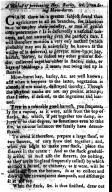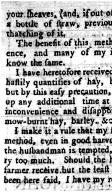[ Method of Preventing Hay, Barley, &C. from Being Mow-Burnt ]
Date: 1767/08/13
Source:
Nova Scotia Gazette
Institution: Nova Scotia Archives
| Source Origin: Nova Scotia Newspapers on Microfilm
| Reference: Consult the Nova Scotia Archives' "Nova Scotia Newspapers on Microfilm" list (Royal Gazette) for a complete account of microfilm reels for this paper. EMMR includes recipes from reel 9466.
Instructions for fashioning grain sheaves to avoid crop damage. Vol. 2, No. 53. Microfilm Reel 9466.
A Method of preventing Hay, Barley, &c. From be-
ing Mow-burnt.
CAN there be a greater subject found than
agriculture in all its branches, for laborious
men to employ their industry, or men of genius
their penetration? It is deservedly a national con-
cern, and not unworthy even the patriot’s care. I
will therefore mention a very easy method (which
probably may not so universally be known as the
utility of it deserves) to prevent mow-burnt hay,
burnet, barley, or indeed any other grain or fod-
der, collected together either in stacks, ricks, or
bays of buildings; I mean, not being tied up in
sheaves.
Mow-burnt hay, barley, &c. are well known;
and when it happens to the latter, vegetation is
almost, if not totally, destroyed thereby: Though
the physical causes are not my present attempt;
that I refer, if desired, to the ingenious and lear-
ned.
Even in a tolerable good harvest, you frequent-
ly see a vapour, as it were, arise from the top of
stacks, &c. which, if put together too damp, in-
jures it to that degree, as sometimes even to take
fire, as various instances too fatally have demon-
strated.
To avoid it therefore, prepare a large sheaf, or
two sheaves, of corn straw tied together; and,
when you begin to make your stack, place the
sheaves in the centre: And as the stack gradual-
ly arises, so must also the sheaves, (or bolting,
as they are in England frequently called) by which
method a funnel, or chimney, as it were, will be
continued from the bottom, so as to collect and
draw up the circumjacent dampness, and discharge
it at the top.
When the stack, &c. is thus finished, draw out
your sheaves, (and, if out of doors,) cover it with
a bottle of straw, previous to the covering or
thatching of it.
The benefit of this method I know by experi-
ence, and many of my industrious neighbours
know the same.
I have heretofore received damage from putting
hastily quantities of hay, barley, &c. together;
but by this easy precaution, (which does not take
up any additional time at all) have avoided the
inconvenience and disappointment arising from
mow-burnt hay, barley, &c.
I make it a rule that my servants adhere to this
method, even in good harvest weather; for often
the husbandman is tempted, in a fine day, to hur-
ry too much. Should the honest and industrious
farmer receive but the least benefit from what has
been here said, I have my reward.
Download: Transcription | Images

